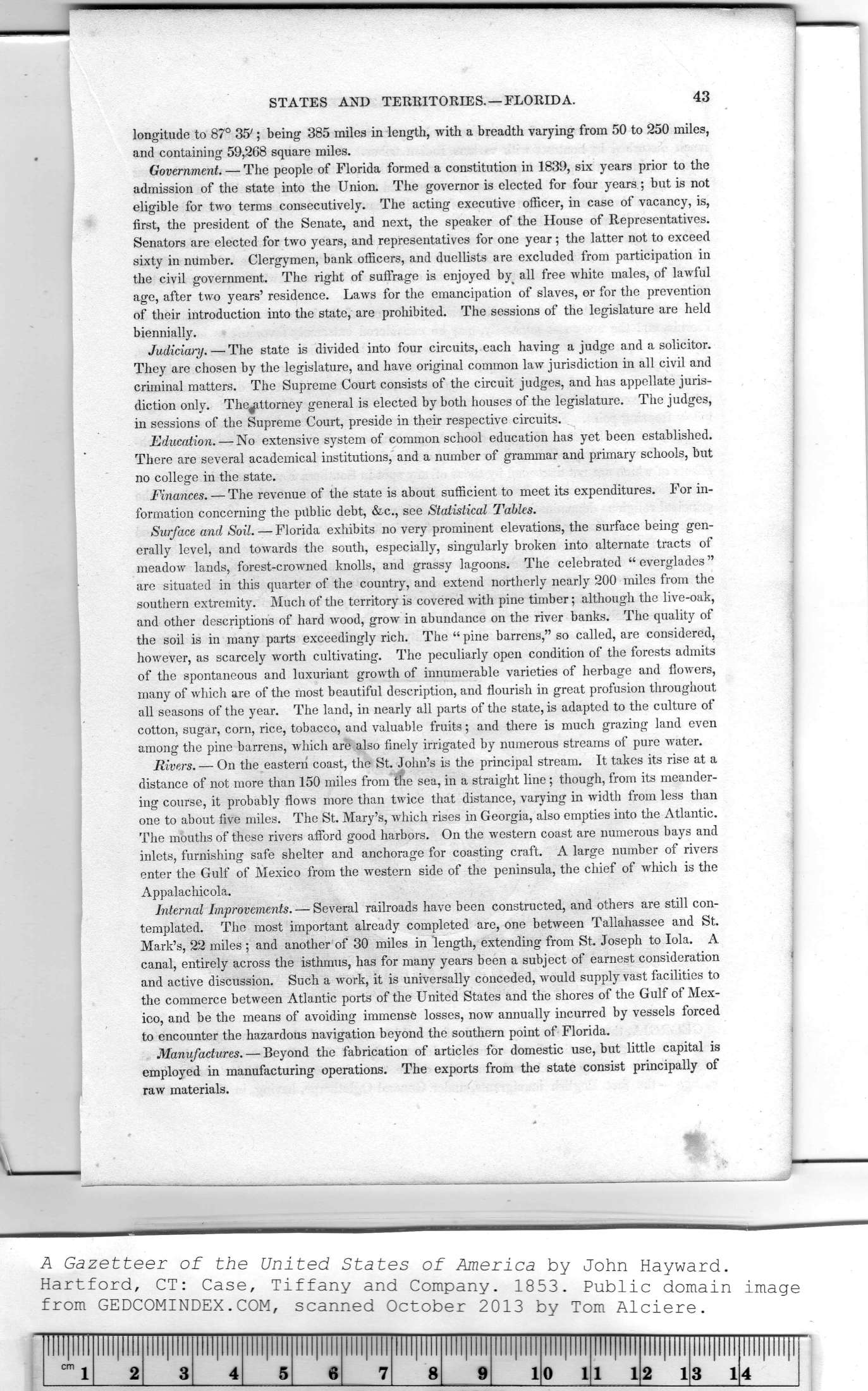|
|
Note: Ctrl and + increases the font size of the text below, Ctrl and - decreases it, and Ctrl and 0 resets it to default size.
STATES AND TERRITORIES.—FLORIDA. 43
longitude to 87° 35;; being 385 miles in length, with a breadth varying from 50 to 250 miles,
and containing 59,268 square miles.
Government. — The people of Florida formed a constitution in 1839, six years prior to the
admission of the state into the Union. The governor is elected for four years ; but is not
eligible for two terms consecutively. The acting executive officer, in case of vacancy, is,
first, the president of the Senate, and next, the speaker of the House of Representatives.
Senators are elected for two years, and representatives for one year ; the latter not to exceed
sixty in number. Clergymen, bank officers, and duellists are excluded from participation in
the civil government. The right of suffrage is enjoyed by_ all free white males, of lawful
age, after two years' residence. Laws for the emancipation of slaves, or for the prevention
of their introduction into the state, are prohibited. The sessions of the legislature are held
biennially.
Judiciary. — The state is divided into four circuits, each having a judge and a solicitor.
They are chosen by the legislature, and have original common law jurisdiction in all civil and
criminal matters. The Supreme Court consists of the circuit judges, and has appellate juris-
diction only. The^ittorney general is elected by both houses of the legislature. The judges,
in sessions of the Supreme Court, preside in their respective circuits.
Education. — No extensive system of common school education has yet been established.
There are several academical institutions, and a number of grammar and primary schools, but
no college in the state.
Finances. — The revenue of the state is about sufficient to meet its expenditures. For in-
formation concerning the public debt, &c., see Statistical Tables.
Surface and Soil.—Florida exhibits no very prominent elevations, the surface being gen-
erally level, and towards the south, especially, singularly broken into alternate tracts of
meadow lands, forest-crowned knolls, and grassy lagoons. The celebrated “ everglades "
are situated in this quarter of the country, and extend northerly nearly 200 miles from the
southern extremity. Much of the territory is covered with pine timber; although the live-oak,
and other descriptions of hard wood, grow in abundance on the river banks. The quality of
the soil is in many parts exceedingly rich. The “ pine barrens," so called, are considered,
however, as scarcely worth cultivating. The peculiarly open condition of the forests admits
of the spontaneous and luxuriant growth of innumerable varieties of herbage and flowers,
many of which are of the most beautiful description, and flourish in great profusion throughout
all seasons of the year. The land, in nearly all parts of the state, is adapted to the culture of
cotton, sugar, corn, rice, tobacco, and valuable fruits; and there is much grazing land even
among the pine barrens, which are also finely irrigated by numerous streams of pure water.
Rivers. — On the eastern coast, the St. John's is the principal stream. It takes its rise at a
distance of not more than 150 miles from the sea, in a straight line ; though, from its meander-
ing course, it probably flows more than twice that distance, varying in width from less than
one to about five miles. The St. Mary's, which rises in Georgia, also empties into the Atlantic.
The mouths of these rivers afford good harbors. On the western coast are numerous bays and
inlets, furnishing safe shelter and anchorage for coasting craft. A large number of rivers
enter the Gulf of Mexico from the western side of the peninsula, the chief of which is the
Appalachicola.
Internal Improvements. — Several railroads have been constructed, and others are still con-
templated. The most important already completed are, one between Tallahassee and St.
Mark's, 22 miles ; and another of 30 miles in length, extending from St.. Joseph to Iola. A
canal, entirely across the isthmus, has for many years been a subject of earnest consideration
and active discussion. Such a work, it is universally conceded, would supply vast facilities to
the commerce between Atlantic ports of the United States and the shores of the Gulf of Mex-
ico, and be the means of avoiding immense losses, now annually incurred by vessels forced
to encounter the hazardous navigation beyond the southern point of Florida.
Manufactures. — Beyond the fabrication of articles for domestic use, but little capital is
employed in manufacturing operations. The exports from the state consist principally of
raw materials.
A Gazetteer of the United States of America by John Hayward.
Hartford, CT: Case, Tiffany and Company. 1853. Public domain ima.
|
